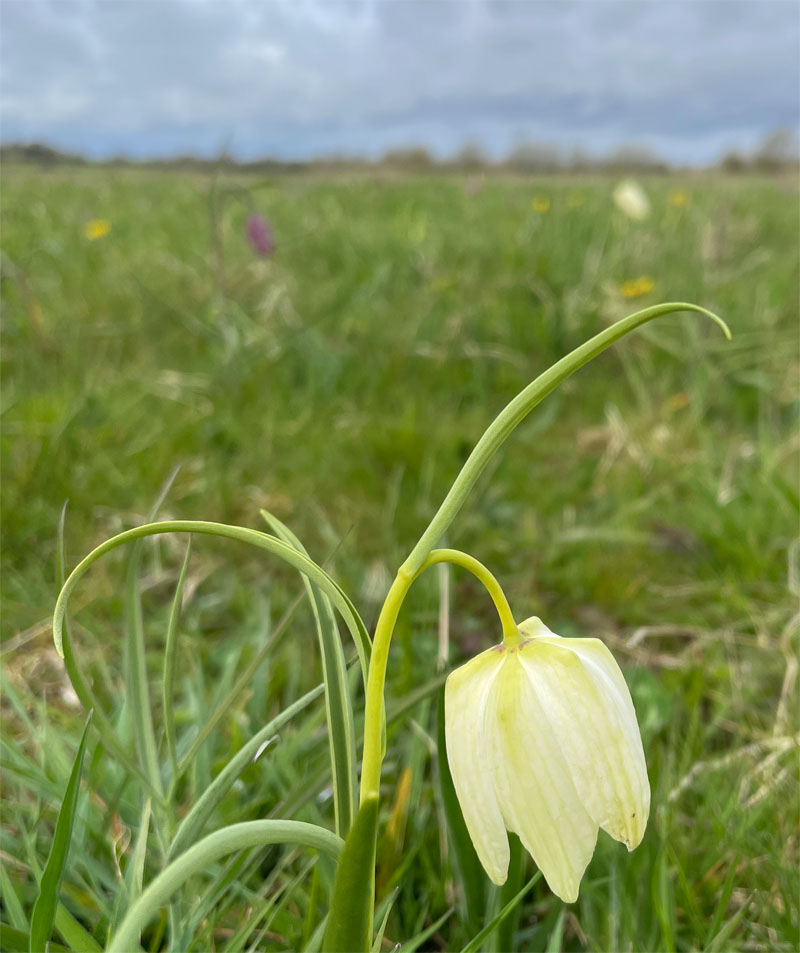Spring. No, it’s winter. Defrosted, then re-frozen. Bright, dull, windy and full of sunshine. April frequently plays games, but this year seems worse than usual. No wonder the daffodils look confused.

Wild plants may have less agency over their lives than animals, but they still have to adapt to forces that, while not actively attempting to oppose them, could be said to be playing a maverick game of chess. The weather, for one; flower early and get bitten by frost; leave it late and be smothered by competing species.
And then, there are people. We have worked this island for thousands of years, bumping into nature and accidentally crafting semi-natural habitats of dazzling sights. Most are rare and fragmented now, kicked away by the much harder footsteps of modern agriculture and development. Many hold wonderful things, but few are prettier than this: the chess flower, more often known as snakeshead fritillary.

It grows in floodplain meadows, those riverside biodiversity treasure houses that for centuries provided hay and late summer grazing. Cricklade North Meadow Natural Nature Reserve’s meadow grows where the Thames spills out – although only a little river here, an infant that has not yet met the concrete banks and busy bridges of London.

It is also flanked by the River Churn, and dotted with boundary stones where ancient commoner rights are still upheld. In the summer, it is a sea of flowers, but the purple glow of the snakeshead – this site holds the majority of the UK population – gives the reserve its fame.

Glamorous, even for a member of the lily family; cryptic in markings, overpowering in the sheer enormity of style. It is no surprise that in former times this flower was much desired indoors as well as nodding in the breeze. Middle-aged country-women with tanned cheek and careworn look daily carry through the streets…large flat baskets of this beautiful flower…in short, there is in Oxford a cult of the fritillary says a newspaper article from 1906. Today, they are safe from being picked because their surviving habitats tend to be Sites of Special Scientific Interest.
Every now and again, a white one interrupts the purple.

A few thousand were out, with many more yet to flower. The snakeshead germinates after exposure to frost, but will not flower until the plant is five or six years old. Fertile for just five days, it is pollinated by bumblebees.
And then the board is set for another round of their show.
I’ve never heard of this snakeshead flower. It’s quite pretty, and I imagine a field of them would be lovely. But your poor daffodil. That photo really tells the story of how this spring has been.
LikeLiked by 1 person
Yes, it’s been tough on the early flowers. The dormice were hiding during last month’s monitoring check despite a spell of good weather – clearly they didn’t trust that winter was done, and they were right!
LikeLiked by 1 person
Sometimes animals seem to sense the approach of bad weather.
LikeLiked by 1 person
What a lovely sight that field must be to see! Such a delicate little flower. Glad to know it is protected. Hopefully, meadow edges and hedgerows will once again be allowed to grow the wild things.
Our weather seems to be stuck on ‘cool’… we can’t seem to get above 10ºC, but at least, it makes for comfortable garden work.
LikeLiked by 1 person
I love their chequered patterning.
Comfortable garden work sounds nice. I was both frozen and boiled in my garden yesterday!
LikeLiked by 1 person
Nice commentary
On fritillary
I’m a chess player
But wouldn’t want
To play w this fella
LikeLiked by 1 person
Thanks Tony.
LikeLike
I’ve never heard of this flower before. So lovely. The daffodil, though; not just confused but frozen! I’m soon going to be on the lookout for the Arctic daffodil – I would love to see one.
LikeLiked by 1 person
I hope you find one! It’s certainly been a trying spring for our daffodils here. We do have wild daffodils in the UK but mostly in damp woods in the south-west. There are lot of garden escapees elsewhere; this one was planted on a road verge.
LikeLiked by 1 person
Looks like northern hemisphere has something in common all over it: unstable spring weather. We just had a big storm – they called it “thundersnow storm” – snow, rain, sleet, you name it, all at once. In Vancouver, after cherries and magnolias bloomed!!! Last year April was warm. This one not so much…
Nice flower – and like the other commenters, never heard of it before 🙂
LikeLiked by 1 person
Oh no! It is rather dispiriting to see blossom broken by late snow. The magnolias here had a very short display thanks to the early April chill. It seems to have stabilised here now and is mostly dry and warm-ish.
I was interested to read that in Croatia, the snakeshead is known as kockavica and considered to be something of a national symbol. I suppose the markings do resemble the coat of arms in the Croatian flag.
LikeLike
I love to see frittilarias, but that frosted daffodil is so perfect, it stole the show!
LikeLike